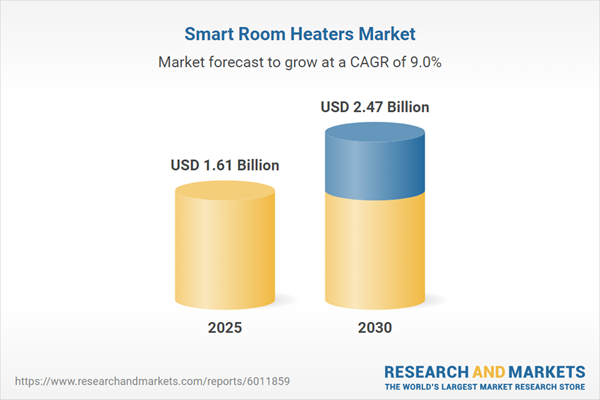Speak directly to the analyst to clarify any post sales queries you may have.
Senior executives are prioritizing the smart room heaters market for its ability to support evolving operational, climate control, and infrastructure requirements within modern commercial and industrial environments. As facility management strategies increasingly focus on intelligent automation and energy stewardship, smart room heating solutions are establishing a new standard for optimized building performance.
Market Snapshot: Smart Room Heaters Market Size & Growth
The global smart room heaters market is demonstrating rapid progression, with revenues projected to increase from USD 1.47 billion in 2024 to USD 1.61 billion by 2025. Over the longer term, forecasts place overall market value at USD 2.99 billion by 2032, indicating a compound annual growth rate of 9.23%. Growth in this sector is driven by increased adoption of intelligent heating systems, enhancements in connected energy management technologies, and a growing preference for solutions that align user comfort with strategic resource efficiency. Organizations are now incorporating climate control strategies that anticipate future trends in building automation and regulatory standards.
Scope & Segmentation of the Smart Room Heaters Market
- Product Types: Fan-enabled smart heaters use adaptive scheduling technology, infrared models offer targeted zone heating with real-time adjustment, oil-filled models maintain continuous, long-duration performance, and radiant heaters efficiently deliver warmth to larger open areas.
- End Use Applications: Residential buyers seek customization and day-to-day comfort; commercial spaces prioritize integration with building management platforms; industrial sites require durable, high-capacity systems for intensive operations.
- Distribution Channels: Direct procurement supports enterprise needs with customized sourcing, mass-market retailers provide broad accessibility, online sellers extend reach, and specialty distributors address unique installation and technical demands.
- Power Output Ranges: Models under 1,000 watts suit compact areas, 1,000–2,000 watt options address standard space requirements, and higher output heaters meet large-space or intensive use needs.
- Connectivity Types: Bluetooth supports local device management, Wi-Fi allows remote and voice interaction, and protocols like Z Wave and Zigbee strengthen automation and secure facility integration.
- Regional Coverage: Market adoption reflects regulatory, infrastructure, and digital transformation differences across the Americas, Europe, Middle East, Africa, and Asia-Pacific.
- Leading Companies Reviewed: The analysis covers participants such as Honeywell International Inc., De’Longhi Appliances S.r.l., A. O. Smith Corporation, Midea Group Co., Ltd., Panasonic Corporation, LG Electronics Inc., Electrolux AB, Samsung Electronics Co., Ltd., Haier Smart Home Co., Ltd., and Whirlpool Corporation, providing insight into sector innovation and industry standards.
Key Takeaways for Senior Decision-Makers
- Integrating automated sensors and intelligent controls into smart room heaters enhances facility energy management and supports enterprise sustainability objectives.
- Ongoing regulatory developments require constant attention to procurement policies, ensuring equipment remains compliant and minimizes operational risk.
- Adoption of interoperable platforms streamlines administrative oversight, reducing complexity and freeing capacity for facility teams to focus on value-added tasks.
- Strategic collaboration among manufacturers and technology providers brings ongoing product innovation and responsive adaptation to new market and environmental priorities.
- As facility connectivity expands, robust cybersecurity and data protection strategies are necessary to safeguard digital assets in increasingly connected environments.
Tariff Impact: United States Import Duties
Anticipated updates to US import tariffs in 2025 prompt organizations to reassess supply chain risks and procurement approaches in the smart room heaters sector. To maintain agility and resilience, senior leaders may consider diversifying supplier relationships, evaluating nearshoring opportunities, and reinforcing collaborations with local manufacturers. Adapting procurement and operational planning in this way helps sustain transparency and flexibility through changing regulatory contexts.
Methodology & Data Sources
This report is based on exhaustive secondary research and in-depth interviews with experts spanning engineering, supply chain, and facility operations. The analysis combines both quantitative market data and qualitative insights, with a focus on the primary drivers shaping the smart room heaters industry and its regulatory framework.
Why This Report Matters
- Assists executive teams in navigating shifts in technology and regulations, sustaining operational momentum during facility modernization efforts.
- Provides transparent product segmentation and a clear competitive overview to inform forward-looking strategic planning for climate control assets.
- Offers actionable intelligence for optimizing procurement and assessing risks connected to sourcing and implementation of advanced heating systems within buildings.
Conclusion
Smart room heaters represent a foundational element of contemporary building management. This analysis offers senior leaders the detailed market insight necessary to guide informed investments and achieve alignment with evolving operational and compliance demands.
Additional Product Information:
- Purchase of this report includes 1 year online access with quarterly updates.
- This report can be updated on request. Please contact our Customer Experience team using the Ask a Question widget on our website.
Table of Contents
3. Executive Summary
4. Market Overview
7. Cumulative Impact of Artificial Intelligence 2025
Companies Mentioned
The companies profiled in this Smart Room Heaters market report include:- Honeywell International Inc.
- De’Longhi Appliances S.r.l.
- A. O. Smith Corporation
- Midea Group Co., Ltd.
- Panasonic Corporation
- LG Electronics Inc.
- Electrolux AB
- Samsung Electronics Co., Ltd.
- Haier Smart Home Co., Ltd.
- Whirlpool Corporation
Table Information
| Report Attribute | Details |
|---|---|
| No. of Pages | 197 |
| Published | October 2025 |
| Forecast Period | 2025 - 2032 |
| Estimated Market Value ( USD | $ 1.61 Billion |
| Forecasted Market Value ( USD | $ 2.99 Billion |
| Compound Annual Growth Rate | 9.2% |
| Regions Covered | Global |
| No. of Companies Mentioned | 11 |









